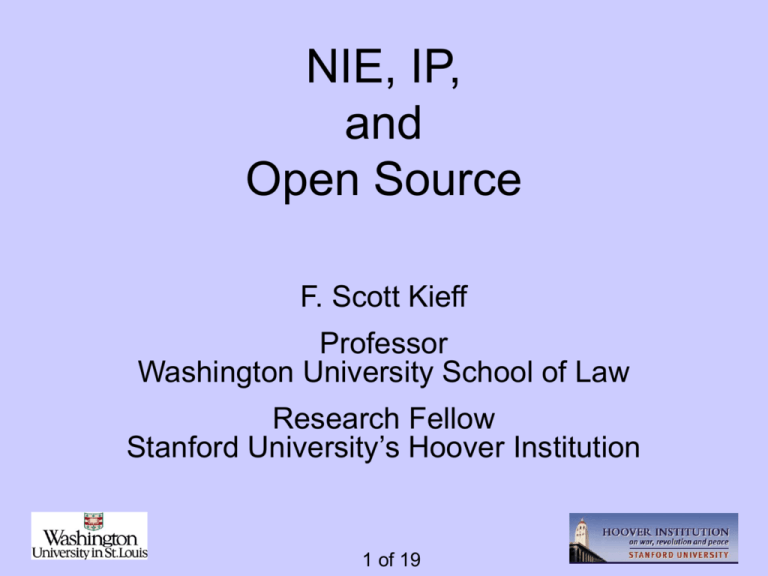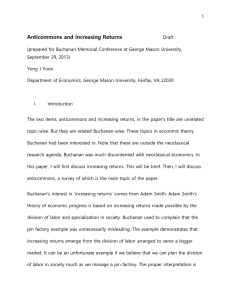NIE, IP, and Open Source
advertisement

NIE, IP, and Open Source F. Scott Kieff Professor Washington University School of Law Research Fellow Stanford University’s Hoover Institution 1 of 19 Property Rights in IP as Keys to Innovation and Competition • Increase innovation – Not just incentives to invent – Get inventions put to use – By facilitating coordination among complementary users of the invention (investors, managers, marketers, laborers, owners of other inventions, etc) – The D part of R&D • Help new companies compete – Anti-monopoly weapons – Vital slingshot for David against Goliath • History: Judge Giles Rich,1952 Patent Act – don’t focus on inventing! (also note Judge Learned Hand and Judge Jerome Frank) 2 of 19 Coordination Mechanisms (See Kieff, Coordination, Property & Intellectual Property: An Unconventional Approach to Anticompetitive Effects & Downstream Access, 56 Emory L.J. 327 (2006)) (See Kieff, On Coordinating Transactions in Information: A Response to Smith’s Delineating Entitlements in Information, 117 Yale L.J. Pocket Part 101 (2007)) • Beacon effect, not control – start conversations • Bargaining effect – get deals struck • Compare liability enforcement rules – Boil everything down to $$, but what about unique assets? – Help get bad coordination done (Keiretsu effect) 3 of 19 Keiretsu Strategy for IP & AT • Consider how big players play with and against each other – They’d love to talk directly – But face two key problems: trust, and antitrust • What if every legal test turns on discretion? – This ensures large numbers of low value IP assets – Which helps them coordinate to keep out competition – Mitigates trust problem: improves communication • Decisions to push and yield transmit preferences • Discovery ensures fidelity – Mitigates antitrust problem: (blessed by Federal Judges) • Insulates from scrutiny generally • Mitigates chance of treble damages and jail time even if scrutinized – Avoids slingshots from Davids 4 of 19 Biotechnology Example • Before 1980, U.S., Europe, & Japan all had NO patents in basic biotechnology, like DNA • After 1980, only the U.S. has patents in biotech –Large increase in number of new drugs & devices actually commercialized –Large pool of ~ 1,400 small & medium biotech companies (Source 2003 Hearing at House Energy & Commerce Committee, Health Subcommittee, Statement of Stanford Associate Dean Phyllis Gardner) 5 of 19 Software Example • No meaningful patents 1972-1996, Microsoft • Major threat to MS is not antitrust • But is Google, using strong patents on search during 1996-2007 window of availability 6 of 19 Benefits of Norm Communities Like Open Source Compared to Property • Any centralization can coordinate • Can rely on informal norms rather than formal rules – Enforcement and other administrative costs can be lower – Enforcement can be more predictable and more effective 7 of 19 Costs of Norm Communities Like Open Source Compared to Property • Attributes of leadership element – such as fame – Not widely accessible, not predictable – Less tradable, bundle-able, and divisible • Problems of crony capitalism – Asset specificity and opportunism for insiders – Decreased diversity – No outsiders • Empirical research shows open source projects actually are very closed, by very small control groups (consider Linus Torvalds and Linux) 8 of 19 Examples of Large Firms and Open Source • Open source is supposed to make everything free (e.g. IBM gives lots of patents to the public these days) – Property rights lead to coordinated development – Avoiding property leads to uncoordinated development – Uncoordinated software increases demand for consulting services – More so than hardware and software, IBM now sells consulting services • Open science is supposed to help science – Merck gave Washington University several million dollars for Human Genome Project on condition of no patents – Example of a biotech firm against patents on its own assets? – No! Big Pharma against patents on its own inputs! (helps Pharma, not biotech or science) 9 of 19 Open Source v. Open Ecosystem? • Why stack deck against one of many business models? – Sell operational software products to customers (hurt by mandated open source) – Help customers get free software to sell them software enhancing service (helped by mandated open source) – Help customers get free software so they don’t mind your selling information about them to advertisers (helped by mandated open source) 10 of 19 Do Contracts Still Bind Symmetrically? • Licensees now can always re-negotiate – Lear (1969) allowed licensees to challenge but post Lear cases made clear licensees had to breach to do so Studiengesellschaft Kohle (Fed. Cir. 1988) – Medimmune (2006) now allows licensees to challenge while holding patentees to rest of deal – Direct contract fixes like covenant not to challenge won’t work • Likely invalid under Lear • What would remedy be? Patentee wants licensee bound to all terms of original deal • Structured deals with stock options like those offered by Sean O’Connor would help; but still don’t reach non-price terms – Dividing deals may be only way to have enforcement (side deal for IP) 11 of 19 Limits on IP Contract Terms • • • • • Brulotte (1964, Douglas) – Post expiration royalties not OK, fear of leverage – Harlan Dissent: why not as financing or as counter of actual benefit? – Cf Scheiber v. Dolby (7th Cir. 2002, Posner) – stipulated both! Aronson (1979, Burger) – 5% royalty while application pending, 2.5% if no patent issues – Held OK because no leverage – facts reflected informed bargaining and betting over different possible outcomes and actual differences in rates depending on different actual outcomes Mallinckrodt (Fed. Cir. 1992, Newman), ProCD (7th Cir. 1996, Easterbrook) – Contractual restrictions to single use or home use OK as long as valid under contract law Quanta (2008) and Univis (1942) – license to one may now license all Bottom line: – Ask for less and give more: use step down rates and add accommodation consideration like tech support etc. – Don’t use words like “license” and instead use “contract,” “settle,” or “promise not to sue” 12 of 19 What about Congressional Thinking on Institutional Design in ’52 Act? • Jettison subjective requirement for “invention” and replace it with Section 103 objective test for “nonobviousness” • Revive contributory and induced infringement • Define what is not misuse • Emphasis on peripheral claiming as opposed to central claiming • Not just different words, different analytical and decisional framework • Today’s separation of powers problems in IP – Courts legislating – Legislatures adjudicating – Agencies overturning courts (FTC Rambus, ITC Tessera) 13 of 19 Institutional Design of Section 271 • (a) direct infringement • (b) inducement – safe harbor of intent • (c) contributory – safe harbors: – Knew it was specially adapted – Not a staple article of commerce • (d) not misuse: – OK to sue, or license – Restrictive licensing – Price discrimination and tying • 1980 Dawson case reaffirming these are not misuse • 1988 amendments adding 271(d)(4 & 5) to make clear these are OK absent evidence of market power • 2006 ITW v III patents not presumption of market power • 2009 reform to add 271(d)(6) to say contracts OK? 14 of 19 Overstated Patent Anticommons • Heller on “anticommons” in the post-socialist environment – Why are so many vendors using kiosks in front of empty storefronts – Why don’t they come in from the cold? – If too many people can say “no” to a use, that use may not occur • But the explanation is wrong: it’s not the number of permissions that matters – It’s the nature of the people from whom permission is needed • Bureaucrats can’t openly sell a “yes” • Patentees can, want to, and do – And the nature of the permission that can be given • Permissions of bureaucrats can’t be enforced against them, or others • Courts enforce patent licenses and bind everyone • Old concepts: License Raj (India), permit thickets (Epstein) 15 of 19 A Comparative Institutional Glance at Patent & Copyright Enforcement • Copyright – Fair use – Statutory damages and criminal liability – Preemption and misuse (iTunes) • Patent – – – – No fair use Owner bears cost of enforcement and must prove damages Vast numbers of low value users given free license Low transaction cost business models for reagents (freezer programs) 16 of 19 At Bottom, the Details Matter: Property Rights at Their Best • Attributes – Predictable enforcement – Good flexibility • Can be traded and licensed • Can be bundled & divided – Users deal with private individuals • Effects 17 of 19 – Easy for market actors to use – Stimulate competition, innovation, economic growth, and jobs At Bottom, the Details Matter: Property Rights at Their Worst • Attributes – Bad flexibility • Created or changed at discretion of government – Rigidity • Fixed owner • Fixed contours – Users deal with government • Effects – Easy for political actors to use (regulators and powerful political constituents) – Concentrate wealth and power Why even call these things property rights? 18 of 19 www.innovation.hoover.org 19 of 19





